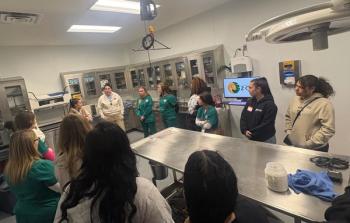
- dvm360 March 2022
- Volume 53
- Issue 3
- Pages: 36
Feline lymphoma: diagnosis and treatment

An experienced clinician discusses the road to success when the diagnostic path is unclear.
Content submitted by Mount Laurel Animal Hospital, a dvm360® Strategic Alliance Partner
Lymphoma is the most common cancer in cats, and it is most frequently located in the gastrointestinal tract.1 Its clinical signs can be vague and include vomiting, diarrhea, weight loss, and inappetence. If an abdominal mass is palpable, it may guide subsequent diagnostic tests. However, not every case is straightforward. Distinguishing high-grade from low-grade lymphoma—and low-grade lymphoma from lymphocytic-plasmocytic enteritis (inflammatory bowel disease [IBD])—can be a challenge. Nonetheless, understanding the disease process can minimize both time to diagnosis and cost.
LOW-GRADE LYMPHOMA
Likely underdiagnosed in cats, low-grade alimentary lymphoma (LGAL), also known as small cell lymphoma, has an indolent course and a slow progression. Owners typically report chronic clinical signs (at a median of 6 months) that may intermittently respond to supportive medications. Results of the physical exam may be normal, or abdominal palpation may reveal either diffuse intestinal thickening (a “ropey” sensation) or an abdominal mass. Initial recommendations are routine blood work, including evaluation for hypocobalaminemia, which in one study was present in 78% of cats.2 Cobalamin is absorbed by the ileum in cats affected by diffuse disease, and the half-life of cobalamin is reduced in cats with gastrointestinal disease. If blood work is normal or palpable abnormalities are present, an abdominal ultrasound is indicated. Sonographic findings typically reveal mild to moderate diffuse circumferential thickening of the small intestinal muscularis propria layer and/or mesenteric lymphadenopathy.3 Notably, intestinal wall layering is nearly always preserved. However, the appearance of the intestinal tract may be normal. Hepatomegaly or hypoechoic echotexture of the liver may also be present. In one study, liver involvement was found in 53% of cats with LGAL.1
If lymphadenopathy is present, fine-needle aspiration cytology can be performed. LGAL is characterized by a predominant population of small lymphocytes. The challenge then is to distinguish it from IBD. Because ultrasound features, clinical signs, and cytology results are often identical in both conditions, an owner who desires a definitive diagnosis should be encouraged to pursue histopathologic testing, although polymerase chain reaction for antigen receptor rearrangement (PARR) on the cytology samples can be useful to reach a diagnosis.
The gold standard for LGAL detection is a full thickness surgical biopsy. However, an endoscopic biopsy, which requires only partial thickness samples and is both less invasive and expensive, can often yield a diagnosis. If results are equivocal, PARR clonality testing can be performed. Although mature T cells form IBD and most LGAL lesions, a neoplastic population undergoes clonal rearrangement, whereas an IBD cell population remains polyclonal. PARR detects lymphoma in 68% to 90% of cases, so a negative PARR result does not rule out lymphoma.4-5 PARR can be run on cytologic or histopathologic specimens.
When it comes to treatment, differentiating between the diseases is of less importance. Initial recommendations for IBD are fecal testing (or deworming), reducing allergen exposure with a novel protein diet, and B12 supplementation if required. Given that B12 functions intracellularly, cats with low-to-normal levels should also receive supplements because they are likely to be deficient in intracellular B12. Some cats respond well to these treatments, but others may require subsequent immunosuppression with prednisolone and, if signs persist, with chlorambucil as well.
The treatment for LGAL is prednisolone and chlorambucil plus B12 supplementation as needed. Clinical improvement may be delayed if hypocobalaminemia is not corrected. Typically, an initial dose of 250 μg SC once a week is recommended. I favor 250 μg SC weekly for 6 weeks, then every other week for 3 months, and once a month thereafter. If clinical remission and normal cobalamin levels are confirmed at this time, the regimen may be discontinued. Chlorambucil—at 20 mg/m2 once every 2 weeks or 2 mg every other or every third day—has been associated with similar outcomes. I prefer the former for improved client compliance. Prednisolone is typically prescribed at 2 mg/kg daily to start, then tapered according to clinical response. More than 80% of cats will respond to treatment, although the response is expected to be slow, and median survival times range from 1.5 to 3 years. Regular blood work and monitoring for weight loss and clinical signs is necessary, and ultrasound exams should be performed every 3 to 4 months if financially feasible. To reduce the risk of chronic impact on the bone marrow, chlorambucil and prednisolone are typically discontinued at 1 year if remission is clinically and sonographically achieved.
If an acute decline occurs or a new abdominal mass is suspected, an ultrasound and ultrasound-guided fine needle aspiration of lesions(s) are indicated. Transition to high-grade intestinal lymphoma can occur; a recent study found an incidence of 10% in cats with a history of LGAL.6 If relapsed LGAL is diagnosed, rescue drugs with positive results include cyclophosphamide and lomustine.
HIGH-GRADE LYMPHOMA
High-grade alimentary lymphoma (HGAL), also called lymphoblastic lymphoma, is characterized by acute onset and progression of clinical signs. Cats with HGAL often present unwell. Physical exam typically reveals an abdominal mass, and sometimes peritoneal effusion. As is the case with LGAL, blood work and an ultrasound scan are indicated. In contrast to the LGAL form, gastric, colonic, and ileal involvement is common. Sonographically, abdominal lymphadenopathy and/or a gastrointestinal mass may be seen, typically with loss of wall layering. If peritoneal effusion is confirmed, it should be sampled. A septic abdomen will require emergency surgery. Perforated or obstructed masses have historically been the only indications for surgery as part of HGAL management. Nevertheless, the diagnosis of lymphoma can sometimes be reached by evaluating any peritoneal effusion. Fine-needle aspiration cytology of an enlarged lymph node or mass can confirm HGAL, which consists of a largely monomorphic population of lymphoblasts (intermediate to large cells). Although uncommon, large granular lymphoma is associated with a poorer prognosis.7 In HGAL, the B-cell form predominates, but PARR is not usually necessary, unless the diagnosis is unclear. Immunophenotyping is less helpful in cats than in dogs with high-grade lymphoma, as it is not known whether type-based treatment adjustments would affect prognosis. Lymphomatous lesions tend to exfoliate well; repeated nondiagnostic cytology samples should raise suspicions that another disease process is occurring.
The recommended treatment for HGAL is a multiagent chemotherapy protocol: CHOP or COP.8 Approximately 50% to 65% of cats will respond, with 30% having a complete response. Single-agent lomustine can be used in cats that do not tolerate frequent injections or whose owners wish to keep costs down. Finally, prednisolone alone is a reasonable option when owners are not interested in chemotherapy.
Response to chemotherapy, indicated by cats that achieve a complete response to treatment, is the most reliable prognostic factor. Cats that achieve complete remission have median survival times of 7 to 10 months, with some surviving more than a year. Cats that do not respond or have only partial remission live significantly less time. Rescue drugs include lomustine, mechlorethamine, cytarabine, and actinomycin-D.
There are preliminary data on surgery and radiation for HGAL. In a small study in which cats underwent surgical debulking of a discrete mass prior to a course of chemotherapy, the median survival time was nearly 14 months.9 Two small studies evaluated abdominal radiation in cats with HGAL, one concurrent with CHOP and another at relapse. Some cats experienced durable remissions.10-11 Further investigations are warranted to evaluate the roles of these modalities for this disease.
Feline patients with lymphoma can have variable clinical presentations, but the history, physical exam, and ultrasound findings can be predictive of type (LGAL or HGAL) and help guide further tests. Given that the treatment recommendations for IBD and LGAL are similar, extended diagnostic testing can be minimized if owners do not wish to pursue costly or invasive procedures in lieu of treatment. Although LGAL is a responsive cancer with a good long-term prognosis, further studies are needed to improve HGAL outcomes.
References
- Vail D, Thamm D, Liptak J, eds. Withrow and MacEwen’s Small Animal Clinical Oncology. 6th ed. Elsevier Health Sciences; 2019.
- Kiselow MA, Rassnick KM, McDonough SP, et al. Outcome of cats with low-grade lymphocytic lymphoma: 41 cases (1995–2005). J Am Vet Med Assoc. 2008;232(3):405-410. doi:10.2460/javma.232.3.405
- Paulin MV, Couronné L, Beguin J, et al. Feline low-grade alimentary lymphoma: an emerging entity and a potential animal model for human disease. BMC Vet Res. 2018;14(1):306-324. doi:10.1186/s12917-018-1635-5
- Weiss AT, Klopfleisch R, Gruber AD. T-cell receptor γ chain variable and joining region genes of subgroup 1 are clonally rearranged in feline B- and T-cell lymphoma. J Comp Pathol. 2011;144(2-3):123-134. doi:10.1016/j.jcpa.2010.08.001
- Hammer SE, Groiss S, Fuchs-Baumgartinger A, et al. Characterization of a PCR-based lymphocyte clonality assay as a complementary tool for the diagnosis of feline lymphoma. Vet Comp Oncol. 2017;15(4):1354-1369. doi:10.1111/vco.12277
- Wright KZ, Hohenhaus AE, Verrilli AM, et al. Feline large-cell lymphoma following previous treatment for small-cell gastrointestinal lymphoma: incidence, clinical signs, clinicopathologic data, treatment of a secondary malignancy, response and survival. J Feline M Surg. 2019; 29(4): 353-362. doi:10.1177/1098612X18779870
- Finotello R, Vasconi ME, Sabattini S, et al. Feline large granular lymphocyte lymphoma: An Italian Society of Veterinary Oncology (SIONCOV) retrospective study. Vet Comp Oncol. 2018;16(1):159-166. doi:10.1111/vco.12325
- Collette SA, Allstadt SD, Chon EM, et al. Treatment of feline intermediate- to high-grade lymphoma with a modified university of Wisconsin–Madison protocol: 119 cases (2004–2012). Vet Comp Oncol. 2016;14(suppl 1):136-146. doi:10.1111/vco.12158
- Gouldin ED, Mullin C, Morges M, et al. Feline discrete high-grade gastrointestinal lymphoma treated with surgical resection and adjuvant CHOP-based chemotherapy: retrospective study of 20 cases. Vet Comp Oncol. 2017;15(2):328-335. doi:10.1111/vco.12166
- Williams LE, Pruitt AF, Thrall DE. Chemotherapy followed by abdominal cavity irradiation for feline lymphoblastic lymphoma. Vet Radiol Ultrasound. 2010;51(6):681-687. doi:10.1111/j.1740-8261.2010.01723.x
- Gieger TL, Seiler GS, Nolan MW. Treatment of feline gastrointestinal intermediate- or large-cell lymphoma with lomustine chemotherapy and 8 Gy abdominal cavity radiation therapy. J Feline Med Surg. 2021;23(6):469-476. doi:10.1177/1098612X20959602
Articles in this issue
over 3 years ago
Lights, camera, action! Welcome to dvm360 LIVE!™over 3 years ago
Corporate practices offer unique opportunities for your careerover 3 years ago
Managing difficult dermatological cases in petsover 3 years ago
The Dilemma: sometimes old is just fineover 3 years ago
Quashing common toxicology mythsover 3 years ago
Surviving burnoutover 3 years ago
Is aging a disease?over 3 years ago
Purina and RedRover bestow 30th Purple Leash Project fundNewsletter
From exam room tips to practice management insights, get trusted veterinary news delivered straight to your inbox—subscribe to dvm360.






